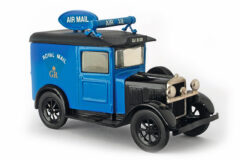The Fordson Dexta is my passion!
Posted by Chris Graham on 18th December 2023
Stuart Tomlins has been a big Fordson Dexta fan for many years, and Bob Weir meets him to find out more about what drives this passion.

Fordson Dexta: Early examples of the Dexta had to compete with the class-leading Massey Ferguson 35, but were always popular with farmers.
Stuart Tomlins runs the family-owned business TO Tomlins Ltd. “We go back several generations,” he explained. “We used to offer plant hire and storage facilities, but these days, we concentrate on haulage. We specialise in oversized loads, which are normally accompanied by an escort vehicle. My youngest son is also a full-time driver and, apart from our yard, I’ve also got a few acres of land which have been in the family for years. This is why tractors and farm machinery come in handy.”
Stuart can remember his grandfather telling him about the days when he used to work with horses. “He was never a full-time farmer but, back in those days, most people worked the land in some way and helped each other,” he said. “The acres are useful, and I currently let them out for grazing sheep. We also cut hay once a year.”
A Shropshire lad
Stuart has lived in Shropshire all his life, and the Dexta (Serial No. 1472096) has been in the family since new. It was first registered on January 2nd, 1961, and originally belonged to his grandfather. According to Stuart, the tractor was a demonstrator at Oakleys, the local dealer.

The Dexta’s controls are straightforward and fall easily to hand.
“My grandfather had bought another plot of land and wanted a tractor to do a few jobs,” he recalls. “The Dexta had been a demonstrator at the local dealership for about a year; tractor dealers evidently kept demonstrators a bit longer in those days, and Oakleys gave the machine a new coat of paint before my grandfather took delivery. He also bought a full set of implements to go with the Fordson and, although most of these have rotted away, I still have the Ransome plough.”
Stuart has witnessed many changes over the years, not least the size of tractors. “They are certainly a lot bigger and more complicated than the tractors we used when I was a boy,” he said. “I remember I had my first go on the Dexta when I was just a toddler. As I recall, my father had sat me on the tractor to keep me quiet. I’ve been told that the Fordson had its ignition in the ‘on’ position and my father had put it into low gear. I’m not sure what I touched but, the next thing I knew, we were trundling across the field and everybody else was in a blind panic! I obviously wasn’t scared, because my father told me later that I had the biggest smile on my face!”
The Dexta is one of the icons of Fordson’s history, and was Fordson’s answer to the popular Massey Ferguson 35. It was based on the American 8N, with the addition of a six-forward-and-two-reverse speed gearbox. The tractor was popular with buyers, sold in large numbers and was given regular upgrades during its production run. It was finally replaced in September 1964 by the worldwide Ford 1000 Series range of machines.
Family help
It was quite common for children to help out with farming duties back in the 1960s and ‘70s and, by the age of 10 Stuart was driving the tractor on a more or less, regular basis. “Looking back, that was nothing unusual,” he told me. “We lived in a rural area, and a lot of my school friends were also brought up with tractors. It was simply a way of life.”

The Dexta was available with a petrol engine, but diesel power accounted for most of the sales.
Now, 60 years on, the Dexta is still firing on all three cylinders, and continues to earn its keep. “The tractor still has less than 1,000 hours on the clock, so you can tell it hasn’t done a lot of work over the years,” Stuart explained. “I mostly use it these days with a wood chipper or log splitter. It can still do lots of useful jobs around the place, and it’s also handy for pulling the Bamford baler.”
Stuart acquired the baler a couple of years ago from a seller on eBay. “I’d been looking for a baler for some time, but they seemed quite expensive,” he recalls. “I then spotted this Bamford on the internet. It was in North Wales and the price was quite reasonable, so I decided to go and check it out,” he recalls. “The Bamford was in really nice condition, and it was obvious that the machine hadn’t been worked hard.
“It had a local history, and the current owner bought it at a farm dispersal sale. It had belonged to his late neighbour, and the current owner had been borrowing it on and off for years. He knew the Bamford’s condition was sound, which is useful when you’re buying secondhand.”
Getting the job done
According to Stuart, the Bamford is slightly smaller than many of its contemporaries, but can still get the job done. “It’s a cracking little baler,” he said. “I use it for my hay, and I reckon it managed 400 bales last year. When it’s not being used, I cover it with a plastic sheet to keep out the weather. I normally clean it out at the end of the season, but I was going on holiday last year and the job was put on the back burner. Now I’ve brought it out, I’ll pull away the rest of the straw before it goes back into storage.”

With only 919 hours recorded over the past 62 years, Stuart’s Dexta has certainly led a pampered life!
The Dexta and baler make an interesting combination and, according to Stuart, the Dexta is fun to drive. “It certainly has enough pulling power, and is easy to steer,” he said. “The brakes are also quite good. It can handle itself on the open road, which is useful if you want to take it on road runs.”
Stuart said the Dexta’s servicing and maintenance have also been straightforward. “It’s never required a lot of attention over the years, apart from routine maintenance,” he explained. “I grew up with tools like a lot of country lads, and Fordson tractors are fairly easy to work on. The tractor is kept under cover, so it stays dry most of the time. However, I admit that the tractor is starting to show its age now, but I’ve decided not to restore it because I like seeing machines like this in their original state. I also think it adds to their authenticity.”
The Fordson has become an integral part of the Tomlins family, and Stuart is keen to keep the tractor around for the foreseeable future. “The Dexta has been with the family for several generations, and is a fond reminder of the past,” he said. “It can still do a job, and it’s certainly nice having it around the place.”
A brief history of Bamford
Bamford was started in 1871 by Henry Bamford and his son, Samuel. The company was based in Uttoxeter, Staffordshire, and specialised in agricultural machinery. During that same year, Bamford acquired some land on the south side of town, in the Leighton district. This was close to the important North Staffordshire Railway and became known as the Leighton Ironworks. Early products included oil cake mills, sheep racks, horse gears, haymakers, milk carriages and horse rakes.

The ‘BL’ family was a popular series of balers. (Pic: Stuart Tomlins)
By 1881, Bamford was employing over 50 men and the sales catalogue ran to 40 pages. This included a full range of agricultural machinery and lift pumps. The company started to buy up rivals like the Lichfield Agricultural Co, and the Leighton Ironworks was later expanded to 10 acres. New products introduced during this period included a self-feeding chaff cutter and a horse-drawn reaper.
In 1913, Bamford was awarded a Royal warrant as agricultural engineers to King George V. Then, at the outbreak of the Great War, Bamford joined the majority of other UK engineering companies and turned its attention to producing war materials. It joined the Birmingham Central Munitions Committee and made hand grenades and artillery shells. In 1916, the business was converted into a private limited company.
Following the end of the war, Bamford started making stationary engines, in addition to its range of agricultural equipment. These ran on diesel, petrol and paraffin, and had a power output of between 2.5 and 6hp.
By the Second World War, Bamford was a thriving business and was placed on the approved list of agricultural machinery manufacturers. This meant it had access to rare resources, although the wartime product range was limited to making mowers. In addition, the company produced radar components, gears and measuring gauges.

The baler and Dexta working together.
During the post-war years, the Leighton works was modernised to produce mowers for Fordson tractors and by 1948, 8,000 of these had rolled off the production line. These included trailer and rear-mounted mowers.
During the 1950s, the company made a variety of balers and other farm machinery, including mowers, side rakes, swath turners and haymaking machinery, manure spreaders, disc harrows, seed drills, plus root cutters and cleaners.
Pick-up balers were particularly important, and an agreement was made between Bamford and the USA-based Long Manufacturing Company, to manufacture balers under licence. The arrangement was a success and Bamford quickly became one of the largest baler manufacturers in the UK. Apart from home sales, the company exported to over 40 countries. It also continued to manufacture engines and had up to 700 employees on its books. In 1968 a takeover bid from family rivals JC Bamford (Excavators), better known as JCB, was rejected.
By the 1970s, Bamford was the UK agent for several foreign agricultural machinery companies, and was manufacturing farm equipment like combine harvesters under license. The popular Kverneland ploughs were first sold in the UK under the Bamford brand. The company eventually stopped trading in 1987.
This feature comes from the latest issue of Ford & Fordson Tractors, and you can get a money-saving subscription to this magazine simply by clicking HERE

Previous Post
Pre-war Morris/Morris-Commercial light vans

Next Post
Life and times of the pocket battleship Admiral Graf von Spee



